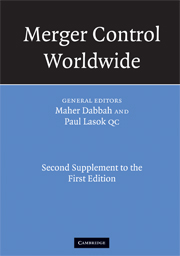Book contents
- Frontmatter
- Contents
- List of contributors
- Table of cases
- Table of legislation
- Introduction to the Second Supplement
- Introduction to the First Supplement
- 1 Argentina
- 2 Armenia
- 3 Australia
- 4 Austria
- 5 Belgium
- 6 Brazil
- 7 Canada
- 8 Chile
- 9 China
- 10 Denmark
- 11 European Union
- 12 Germany
- 13 Greece
- 14 Iceland
- 15 Italy
- 16 Japan
- 17 Republic of Korea
- 18 Malta
- 19 Mexico
- 20 The Netherlands
- 21 New Zealand
- 22 Norway
- 23 Singapore
- 24 Spain
- 25 Switzerland
- 26 Taiwan
- 27 Ukraine
- 28 United Kingdom
- 29 United States of America
- Index
8 - Chile
Published online by Cambridge University Press: 30 July 2009
- Frontmatter
- Contents
- List of contributors
- Table of cases
- Table of legislation
- Introduction to the Second Supplement
- Introduction to the First Supplement
- 1 Argentina
- 2 Armenia
- 3 Australia
- 4 Austria
- 5 Belgium
- 6 Brazil
- 7 Canada
- 8 Chile
- 9 China
- 10 Denmark
- 11 European Union
- 12 Germany
- 13 Greece
- 14 Iceland
- 15 Italy
- 16 Japan
- 17 Republic of Korea
- 18 Malta
- 19 Mexico
- 20 The Netherlands
- 21 New Zealand
- 22 Norway
- 23 Singapore
- 24 Spain
- 25 Switzerland
- 26 Taiwan
- 27 Ukraine
- 28 United Kingdom
- 29 United States of America
- Index
Summary
Introduction
Since the publication of the Main Work, the major event in the Chilean merger control scene has been the publication by the Fiscalía Nacional Económica (FNE, the governmental entity in charge of investigating competition law violations) of its non-binding guidance (the “Guidelines”) in October 2006 on different aspects of merger review, including the criteria that the FNE shall use when analysing horizontal integration cases (but excluding vertical integrations).
The FNE has incorporated in the Guidelines some principles or criteria that were already applied by the Chilean Antitrust Court. The Guidelines include an important clarification: they fix the threshold of degree of concentration that the FNE will use based on the Herfindahl–Hirschman Index.
Degree of concentration
After determining the companies participating in a relevant market (including those based outside Chile, when applicable), the FNE will establish market shares mainly by considering the sales of each participant in monetary terms; however, the FNE may use other considerations to complement or replace sales (e.g. sales in units, production and installed capacity, inventory and reserves of natural resources).
The FNE will use the Herfindahl–Hirschmann Index (HHI) to measure the levels of concentration of a particular market before and after a merger or acquisition. The FNE will deem that an operation does not have anticompetitive effects, if:
the post-merger HHI is less than 1,000;
the post-merger HHI is between 1,000 and 1,800 (this value indicates a moderately concentrated market) and the variation of the HHI resulting from the merger is below 100; or
the post-merger HHI is greater than 1,800 (this value indicates a highly concentrated market) and the variation of the HHI resulting from the merger is below 50.
- Type
- Chapter
- Information
- Merger Control WorldwideSecond Supplement to the First Edition, pp. 32 - 33Publisher: Cambridge University PressPrint publication year: 2008

